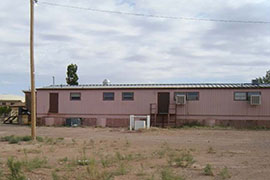- Slug: BC-CNS-Navajo Schools,540
- Sidebar: Schools from the 2004 list.
- Photo available (thumbnail, caption below)
By MIRANDA LEO
Cronkite News
WASHINGTON – Eleven years after it identified two deteriorating Navajo schools as priorities for replacement, the federal government could finally be ready to fully fund those projects. Next year.
Cove Day and Little Singer Community schools are the last two of 14 Indian schools across the country that were identified in 2004 as being in highest need of replacement. The fiscal 2016 budget proposal released this week includes $45 million for school replacement construction in the Interior Department budget, said Secretary Sally Jewell, who conceded the allocation is long overdue.
“It’s hard not to feel sad and angry when I look at the conditions of the facilities,” Jewell said in a conference call last week announcing the funding.
Cove Day School was built more than 50 years ago and has asbestos in its insulation, according to an official with the Bureau of Indian Affairs. Little Singer Community School, built more than 30 years ago, suffered water damage because of missing roof tiles that led to mold in the building, which in turn led to the possible exposure of asbestos underneath the flooring of its kitchen building.
Ahniwake Rose, executive director of National Indian Education Association, said that tribal nations and their school systems are largely dependent on federal funding because of limitations on the way tribal governments can levy taxes.
“This system is flawed and needs to be fixed,” Rose said. “No school should have to wait a decade for repairs.”
She said the already-slow process of funding school construction was further sidetracked by the automatic cuts to the federal budget known as sequestration in 2013, which also stopped a new list from being made that year.
Quinton Roman Nose, executive director of the Tribal Education Departments National Assembly, said that he has dealt with the same gridlock in his work as president of a school board.
“By no means should it take as long as it takes,” he said. “I don’t like to think about it.”
“Some of these situations with bureau schools could have been alleviated if they had processed the building in a timely manner with the amount of funding that was available,” Roman Nose said.
While they wait, students have to continue trying to learn in those decaying buildings, some of which only meet the bare minimum to function, said Walter Phelps, a Navajo Nation Council delegate.
“If environmental health were to take a very close look, they might shut down some classrooms,” he said.
Phelps said Cove Day and Little Singer Community schools are hardly the only Navajo schools in need. Like Rose, he emphasized the need for a new list.
Jewell agreed, and praised staffers in those schools who have had to work hard to make ends meet. She specifically cited a Hopi school, Moencopi Day School, where half the students are in portable classrooms that are more than 30 years old. Despite those shortcomings, the school is making strides due to the “dedicated principal, staff and students” there, Jewell said.
The White House plan still needs to be approved by Congress, but Jewell said she is confident that the funding for Indian education will be in any final budget.
“There’s strong bipartisan support,” she said. “There’s no debate that we are not serving Indian children well.”
^__=
Web links:
_ 2004 school replacement post: https://www.federalregister.gov/articles/2004/03/24/04-6533/replacement-school-construction-priority-list-as-of-fy-2004
_ White House budget fact sheet: http://www.whitehouse.gov/sites/default/files/omb/budget/fy2016/assets/fact_sheets/standing-with-indian-country.pdf
_ BIA budget fact sheet: http://www.bia.gov/cs/groups/public/documents/text/idc1-029264.pdf
^__=
SIDEBAR:
Long time coming
Cove Day School and Little Singer Community School, both in the Navajo Nation, are the last of 14 tribal schools that were deemed priorities for replacement by the federal government in 2004. The other schools, and the dates for final action on the projects:
– Dilcon Community School (Navajo, Arizona): 2009
– Porcupine Day School (Pine Ridge Oglala Lakota/Sioux, South Dakota): 2009
– Muckleshoot Tribal School (Muckleshoot,Washington): 2009
– T’iists’oozi’bi’olta (Crownpoint) Community School (Navajo, New Mexico): 2010
– Keams Canyon Elementary School (Navajo, Arizona): Removed from list.
– Rough Rock Community School (Navajo, Arizona): 2011
– Crow Creek Elementary/Middle/High School (Crow Creek Sioux, South Dakota): 2012
– Circle of Life Survival School (White Earth, Minnesota): 2012
– Kaibeto Boarding School (Navajo, Arizona): 2012
– Dennehotso Boarding School (Navajo, Arizona): Scheduled completion late 2014.
– Blackfeet Dormitory (Blackfeet, Montana): Project does not appear to be completed
– Beatrice Rafferty School (Passamaquoddy, Maine): Funding approved last month
^__=
The kitchen building at Little Singer Community School in the Navajo Nation is plagued with mold and possible asbestos problems. It was first targeted for replacement more than 10 years ago. (Photo courtesy the Bureau of Indian Affairs)
